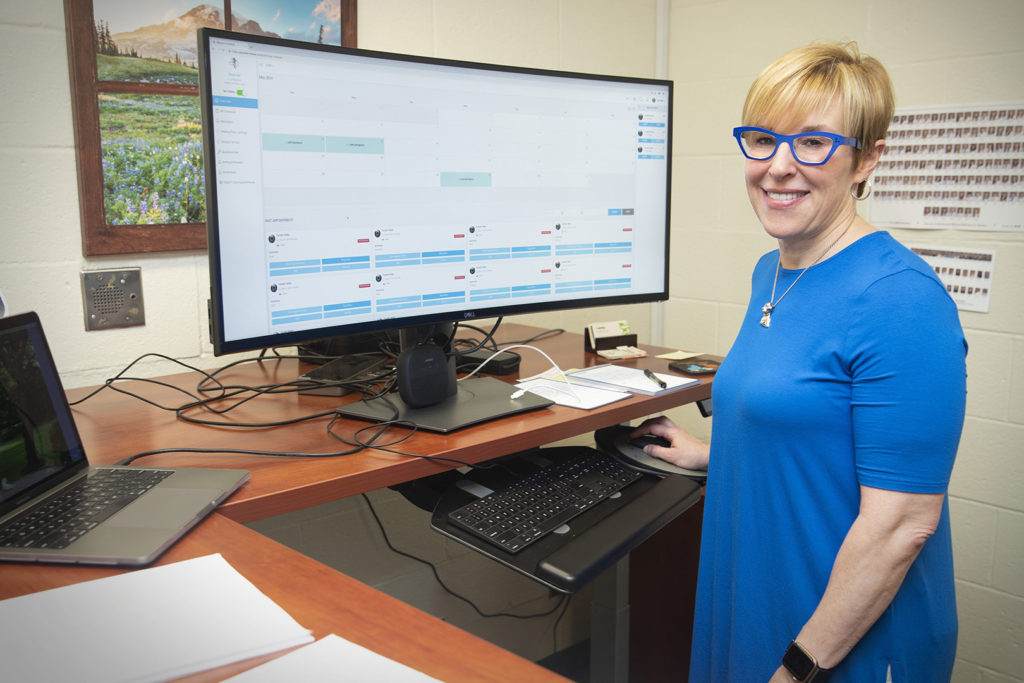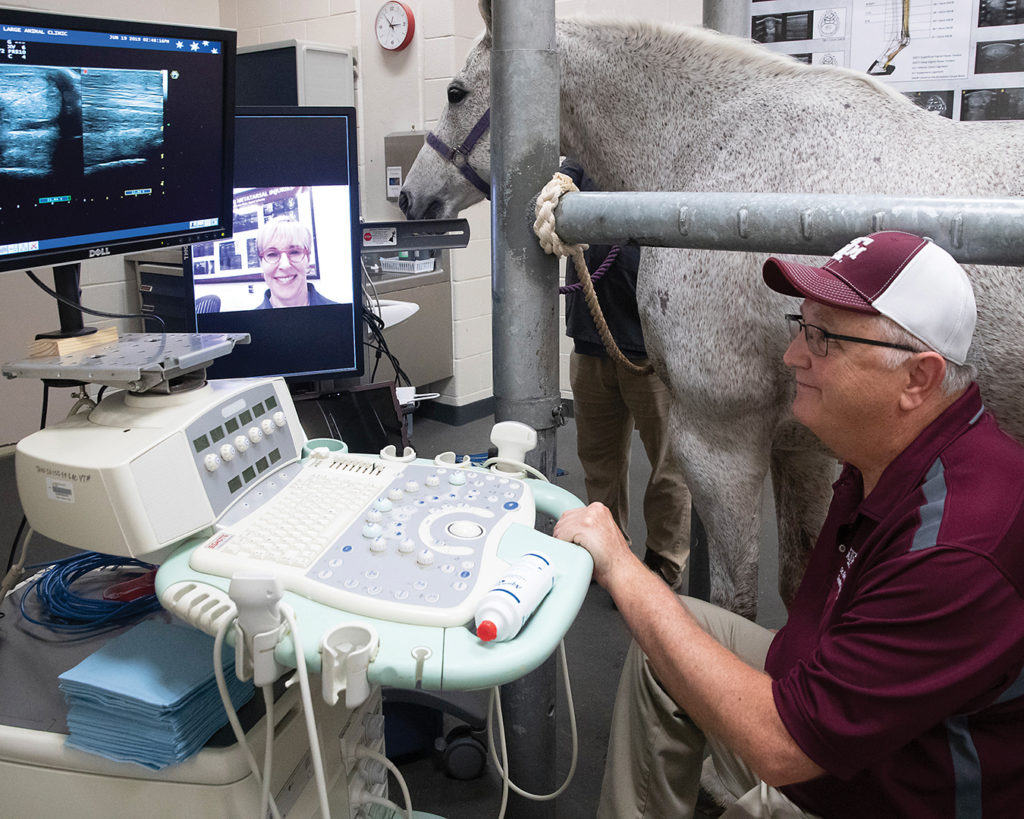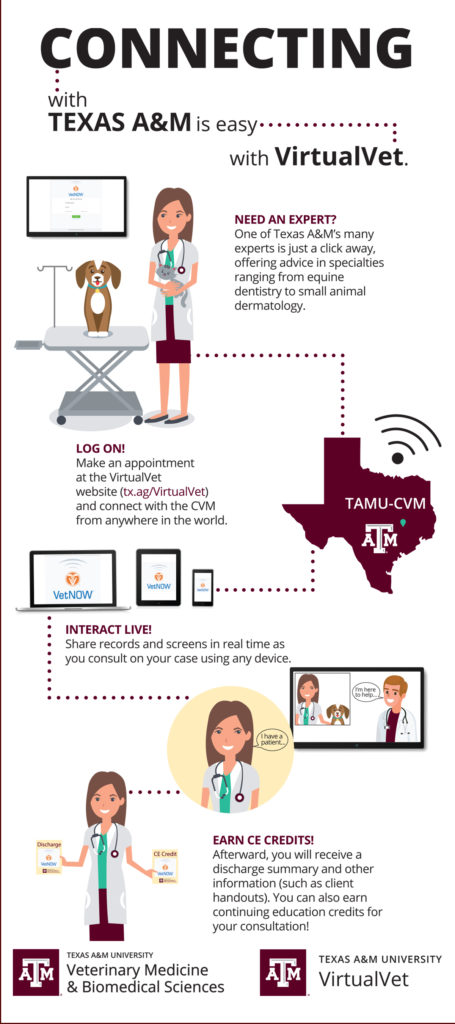Blazing New Trails
Story by Dr. Ann Kellett
Dr. Lori Teller explores the endless applications of telemedicine in the Texas A&M Veterinary Medical Teaching Hospital (VMTH) as the first university-based veterinary telehealth expert.

Dr. Lori Teller says telehealth—connecting veterinarians and clients electronically so that care can be provided without the time and expense of travel—is a game-changer, and Texas A&M once again is at the forefront.
As the world’s first university-based veterinary telehealth expert, she should know.
Teller gained expertise in telemedicine, in 2015, when she was in private practice and joined the board of directors of the American Veterinary Medical Association (AVMA).
“Telemedicine has been available in human health care for decades, and the handwriting was on the wall that it was coming to veterinary medicine,” she said. “I suggested that this was something the AVMA should look into and a working group was formed. I was its liaison to the board.”
The working group had more than 50 members, including veterinarians, legal and policy experts, and other stakeholders. The AVMA adopted the telemedicine policy they developed in July 2017.
“I think what we learned opened a lot of eyes,” she said.
In 2018, she enthusiastically accepted the opportunity to focus on veterinary telemedicine at her alma mater.
“I still have to pinch myself,” she said about returning as a CVM faculty member. “I walk in the shadows of giants—those who educated me and helped shape my career. I never imagined as a student, or as a private practitioner, that I would be worthy of following in their footsteps.”
Following Giants While Blazing A New Trail

“I think we’re going to see a lot more virtual care,” she said.
For one thing, accessing a veterinarian from home brings clients peace of mind during potential—or real—emergencies.
“Let’s say a dog owner comes home late at night and finds vomit on the floor but her dog is acting fine,” Teller said. “Does she need to go to the emergency clinic or can it wait until morning? Virtual care reduces the stress involved in figuring out what to do.”
It also is an ideal way to provide care in non-emergency areas such as behavior and nutrition.
“Animals often hide their ailments at the hospital,” Teller said. “So once a physical exam is conducted to determine if there is a disease, future visits could be done virtually so the patient is in its own environment and acts naturally.”
Virtual care also reduces obstacles for clients who cannot easily visit a veterinarian because of financial, health, or transportation issues.
Veterinary telehealth also benefits practitioners.
“Our clinicians can work virtually with general practitioners in remote areas of the state who are dealing with an unusual case or procedure, and if a referral is needed, then the client, the referring DVM, and the specialist at Texas A&M are already prepared for what to expect,” she said.
Giving these veterinarians—as well as new practitioners—access to a specialist who will help guide them through a problem can make the veterinarian feel less alone while gaining new knowledge and skills.
What’s Next For Telehealth

In the next few months, the CVM will provide virtual consults to veterinarians around the state to provide just such guidance, from how to treat a complicated canine dermatology case to real-time guidance when performing an ultrasound on a horse.
“What’s particularly great about the service we’ll be providing is that a discharge summary and other information, such as client handouts or scientific articles, can be provided at the end of the virtual visit,” Teller said. “Not only that, but the referring DVM can get continuing education credits for the consult. We are very excited about this unique aspect of what we are offering.”
Over the next few years, Teller predicts a major increase in the number of practices that incorporate virtual care for recheck visits, triage, and more.
“As the technology improves and people get more comfortable using it, the laws and regulations will adapt appropriately,” she said.
Remote care monitoring is another area with potential.
“This is a big growth area in human health care right now, and it will eventually move into our realm, too” Teller said.
For example, remote care monitoring would help veterinary practices that need to hospitalize an animal overnight but don’t have around-the-clock staffing. Animals with heart disease, diabetes, or other chronic diseases also would benefit from continuous monitoring.
“As wearable technology improves, the data from wearables can be uploaded in real time and an alert sent to the owner if something is off and requires veterinary attention,” Teller said.
Augmented intelligence and virtual reality will also play a bigger role in veterinary care.
“It will be possible for one of our surgeons to remotely help a surgeon in another city or even another country—a tremendous benefit for people in underserved areas or developing countries,” Teller said. “The applications are endless. It will be possible, for example, to overlay an MRI image onto the patient to more precisely guide where incisions should be made and where to watch out for nerves or vessels.”
Getting It Right At The CVM
Teller decided to become a veterinarian at age 6 and started working for her family’s veterinarian in Houston at age 12.
“I fainted on my first day!” she said. “But I was hooked.”
Since joining the CVM faculty, she has been impressed by the spirit of innovation and collaboration.
“The CVM offers tremendous opportunities to try new things,” she said. “The human health care providers did many things well with telehealth, but also made mistakes. We can learn from them and get it right for our colleagues, clients, and patients.”
Teller is confident that animals that do not currently receive veterinary care, or the level of care required, will soon have opportunities to get help through the CVM’s telehealth programs.
“Just like anything else worth doing, virtual care is worth doing well, and of course, there is a cost to making this new work happen,” she said. “We are grateful to those who support us. I would tell each of them that no profession is more exhilarating than veterinary medicine!”
###
Note: This story originally appeared in the Fall 2019 edition of CVMBS Today.
For more information about the Texas A&M College of Veterinary Medicine & Biomedical Sciences, please visit our website at vetmed.tamu.edu or join us on Facebook, Instagram, and Twitter.
Contact Information: Jennifer Gauntt, Director of CVMBS Communications, Texas A&M College of Veterinary Medicine & Biomedical Sciences; jgauntt@cvm.tamu.edu; 979-862-4216



